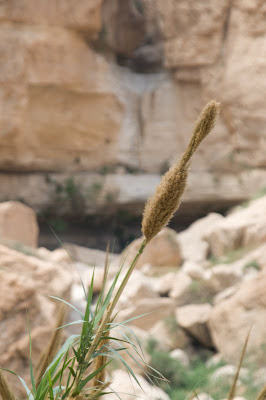By the way, both of my cameras are broken, so all credit for these photos goes to Yuval, who brought a massive SLR-style professional camera. I have to admit is was quite a relief to just enjoy the tiyul and not be taking photographs at every twist and turn in the road, knowing that Yuval was snapping away.
Our first stop was in Mitzpeh Yericho (approximately, Jericho Vista,) which overlooks the sprawling city of Jericho in the Jordan Valley.
Looking south, a mosque adorned with palm trees sits in the distance.
This building is what the Arabs call "Nabi Mussa," "Nabi" being the Arabic cognate of the Hebrew, "Navi," or prophet, and "Mussa" being Moshe, or Moses. The Arabs built this on what they believed to be the grave of Moshe. Of course, as we know from the book of Deuteronomy, Moshe was not buried in Eretz Yisrael. He was not even permitted to cross over the Jordan River, but died on the other side. Also, Moshe is one of our few biblical ancestors whose grave is unmarked. But we do know that his grave was on Har Nevo.
So what is the root of this Muslim belief? After all, much of the Torah and Talmud was incorporated into the Koran, albeit with glaring inaccuracies, and most Arab cities still preserve the original Hebrew place names, so it seems that the Arabs would likewise have adopted this custom based on some preexisting native Jewish custom.

Nabi Mussa
If you drive up to the site, one thing you will notice is that Nabi Mussa provides the closest unobstructed view of Har Nevo. It seems reasonable that on Moshe's Yahrtzeit (the anniversary of his death,) Jews would schlep from Jerusalem down to this spot and read Tehillim (Psalms) in view of the place of his burial. A passing Arab might ask, "Hey, what are you guys doing?" To which they would respond, "Remembering the passing of our Teacher Moshe." The Arab would then get the idea that this was the very spot of his burial. It's the most reasonable theory.
And so we continue on our merry way, passing 300 Meters below sea level.

Looking south: the highway from Yericho (Jericho) to Yerushalayim (Jerusalem.) This is the road that was sung about in mournful tones by Naomi Shemer in her song, "Jerusalem of Gold," written before the Six Day War, when Jews were still banned from travelling on this road:

How the cisterns have dried The market-place is empty
And no one frequents
the Temple Mount In the Old City.
And in the caves in the mountain Winds are howlingAnd no one descends to
the Dead Sea By way of Jericho.

Today, it's a modern highway. A second set of lanes has been opened this month, and now it's a full four-lane highway. At the bottom, we hang a right, going south, at what is the lowest traffic circle on the face of the earth at 400 meters below sea level, and pass by Qumron.
 You can spot some of the caves in the cliffs at Qumron.
You can spot some of the caves in the cliffs at Qumron. The ruins of the city of Qumron itself is on top of the lower, lighter-colored cliffs.
The ruins of the city of Qumron itself is on top of the lower, lighter-colored cliffs.Eventually, we reach the Ein Gedi nature reserve, and enjoy views of some of the wildlife.
 At 400 meters below sea level, this is the lowest Ibex on the face of the Earth.
At 400 meters below sea level, this is the lowest Ibex on the face of the Earth.Ein Gedi (the Gedi Spring) is fed by a natural underground aquifer. During the rainy season, when it really starts coming down, the spring water is augmented by flash floods which carry away cars, boulders, and hikers.
Leaving the Ein Gedi waterfall behind...
 ... we continue on the trail.
... we continue on the trail. Some sort of condor flies ahead of us.
Some sort of condor flies ahead of us. Goofing off on the trail.
Goofing off on the trail. Looking across the Dead Sea at Jordan.
Looking across the Dead Sea at Jordan. This looks like a field school, or guest lodging, or something like that.
This looks like a field school, or guest lodging, or something like that. After about half an hour, in a roundabout sort of way, we reached the top of the falls.
After about half an hour, in a roundabout sort of way, we reached the top of the falls.
A few seconds later we all jumped in. Quite refreshing!
 Sha'i, our Madrich, makes it to the top!
Sha'i, our Madrich, makes it to the top!For the Barbecue itself, we actually got quite lucky. A squad of paratroopers was having a barbecue next to ours. Being army guys, they had taken way, way more meat than they needed, so we inherited several pounds of chicken and kebab to augment our already sumptuous bounty of hamburgers. Our intrepid bus driver volunteered to run the grill.


















No comments:
Post a Comment